World Trade Organization (WTO) Law: Nairobi Summit and Disputes
VerifiedAdded on 2021/10/08
|16
|5080
|70
Essay
AI Summary
This assignment delves into the World Trade Organization (WTO), examining its objectives, successes, and failures, with a specific focus on the Nairobi summit. The analysis highlights the WTO's challenges in supporting developing nations, particularly concerning agricultural trade and the Doha Round agenda. The assignment also provides a detailed overview of the WTO's dispute resolution mechanism, outlining the steps involved, from consultation to the appeal process, and assessing its effectiveness in resolving trade conflicts. The paper discusses the influence of developed nations and the arms industry on the WTO's operations and the limitations faced by developing countries. The assignment provides a comprehensive understanding of the WTO's role in global trade and its impact on various nations.
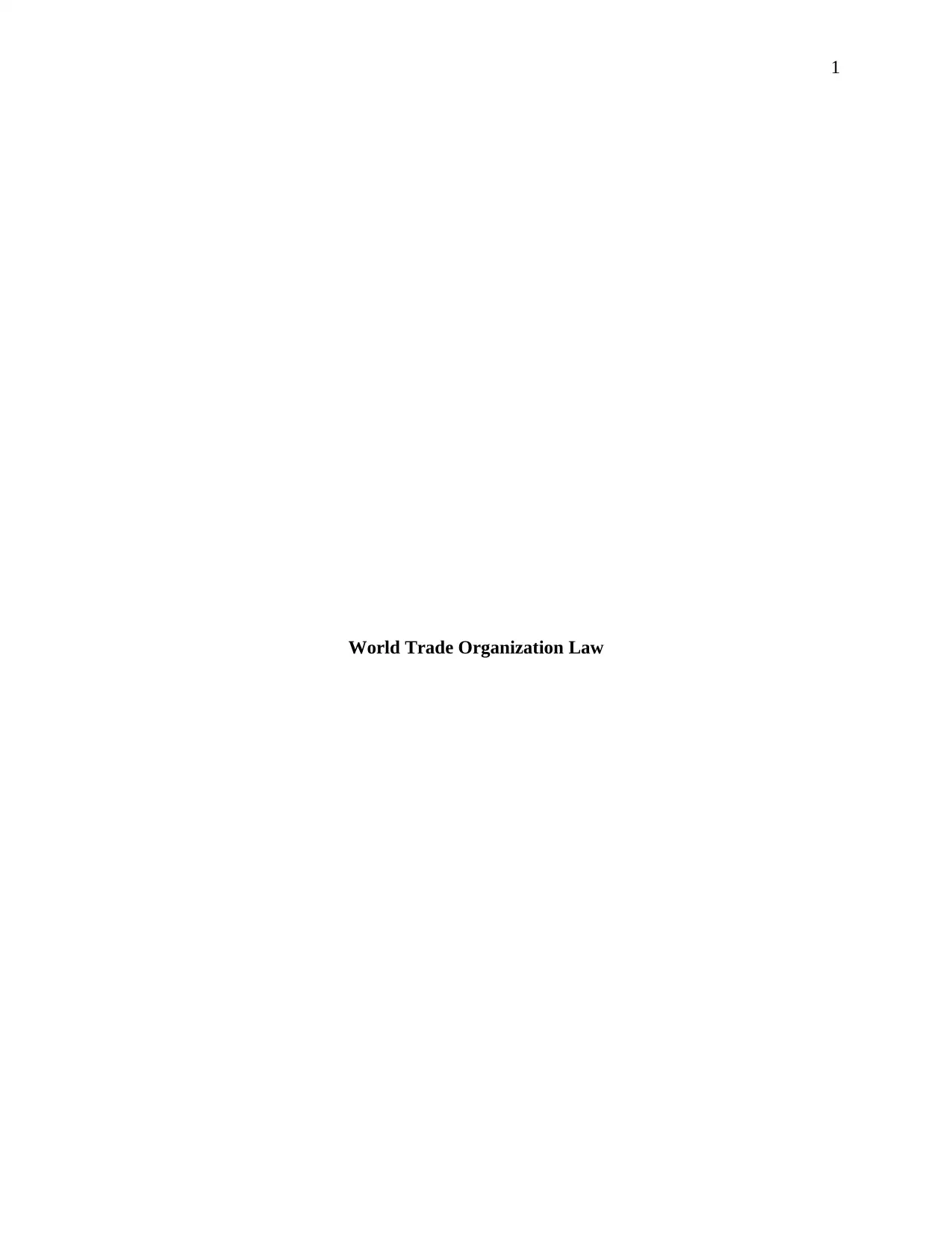
1
World Trade Organization Law
World Trade Organization Law
Paraphrase This Document
Need a fresh take? Get an instant paraphrase of this document with our AI Paraphraser
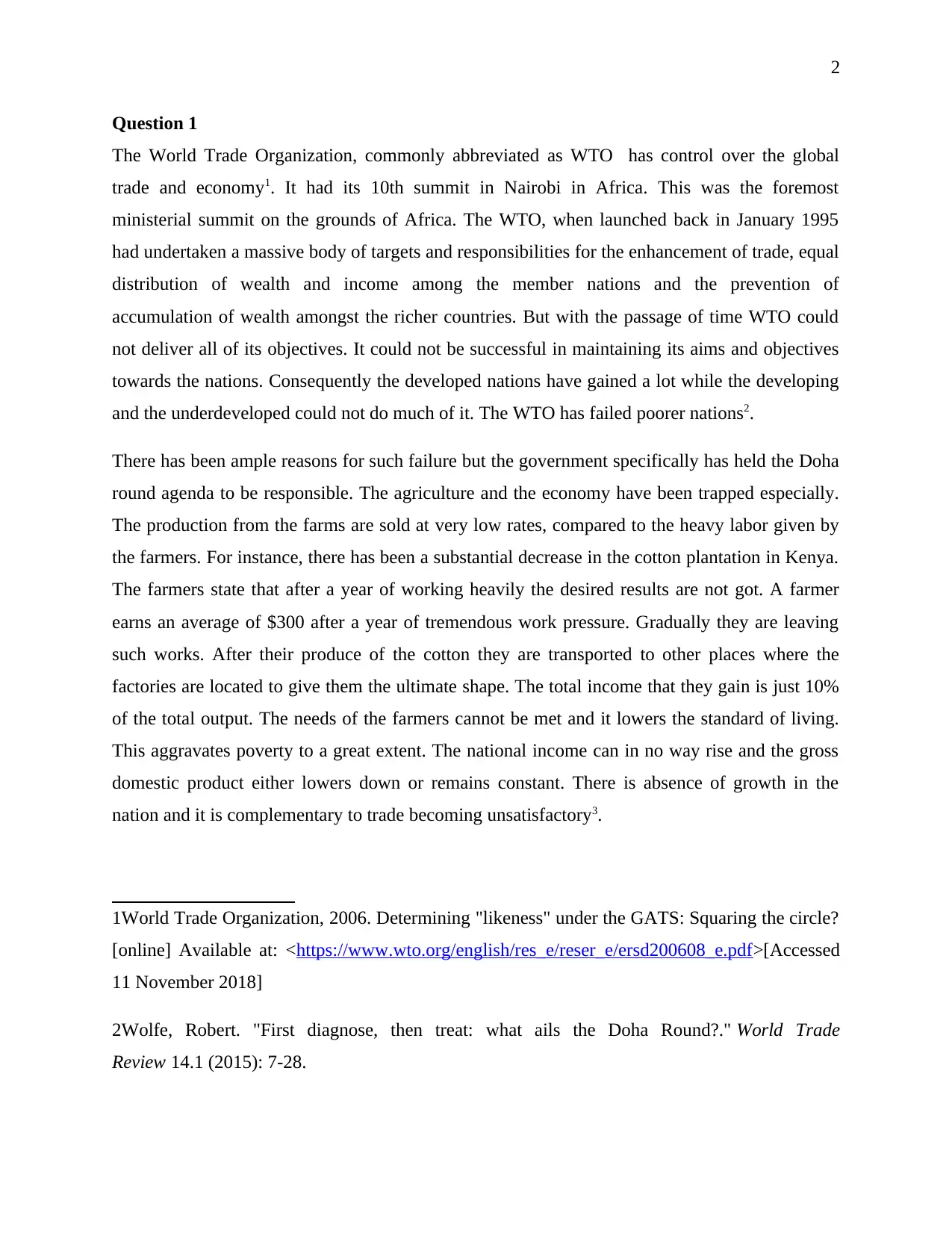
2
Question 1
The World Trade Organization, commonly abbreviated as WTO has control over the global
trade and economy1. It had its 10th summit in Nairobi in Africa. This was the foremost
ministerial summit on the grounds of Africa. The WTO, when launched back in January 1995
had undertaken a massive body of targets and responsibilities for the enhancement of trade, equal
distribution of wealth and income among the member nations and the prevention of
accumulation of wealth amongst the richer countries. But with the passage of time WTO could
not deliver all of its objectives. It could not be successful in maintaining its aims and objectives
towards the nations. Consequently the developed nations have gained a lot while the developing
and the underdeveloped could not do much of it. The WTO has failed poorer nations2.
There has been ample reasons for such failure but the government specifically has held the Doha
round agenda to be responsible. The agriculture and the economy have been trapped especially.
The production from the farms are sold at very low rates, compared to the heavy labor given by
the farmers. For instance, there has been a substantial decrease in the cotton plantation in Kenya.
The farmers state that after a year of working heavily the desired results are not got. A farmer
earns an average of $300 after a year of tremendous work pressure. Gradually they are leaving
such works. After their produce of the cotton they are transported to other places where the
factories are located to give them the ultimate shape. The total income that they gain is just 10%
of the total output. The needs of the farmers cannot be met and it lowers the standard of living.
This aggravates poverty to a great extent. The national income can in no way rise and the gross
domestic product either lowers down or remains constant. There is absence of growth in the
nation and it is complementary to trade becoming unsatisfactory3.
1World Trade Organization, 2006. Determining "likeness" under the GATS: Squaring the circle?
[online] Available at: <https://www.wto.org/english/res_e/reser_e/ersd200608_e.pdf>[Accessed
11 November 2018]
2Wolfe, Robert. "First diagnose, then treat: what ails the Doha Round?." World Trade
Review 14.1 (2015): 7-28.
Question 1
The World Trade Organization, commonly abbreviated as WTO has control over the global
trade and economy1. It had its 10th summit in Nairobi in Africa. This was the foremost
ministerial summit on the grounds of Africa. The WTO, when launched back in January 1995
had undertaken a massive body of targets and responsibilities for the enhancement of trade, equal
distribution of wealth and income among the member nations and the prevention of
accumulation of wealth amongst the richer countries. But with the passage of time WTO could
not deliver all of its objectives. It could not be successful in maintaining its aims and objectives
towards the nations. Consequently the developed nations have gained a lot while the developing
and the underdeveloped could not do much of it. The WTO has failed poorer nations2.
There has been ample reasons for such failure but the government specifically has held the Doha
round agenda to be responsible. The agriculture and the economy have been trapped especially.
The production from the farms are sold at very low rates, compared to the heavy labor given by
the farmers. For instance, there has been a substantial decrease in the cotton plantation in Kenya.
The farmers state that after a year of working heavily the desired results are not got. A farmer
earns an average of $300 after a year of tremendous work pressure. Gradually they are leaving
such works. After their produce of the cotton they are transported to other places where the
factories are located to give them the ultimate shape. The total income that they gain is just 10%
of the total output. The needs of the farmers cannot be met and it lowers the standard of living.
This aggravates poverty to a great extent. The national income can in no way rise and the gross
domestic product either lowers down or remains constant. There is absence of growth in the
nation and it is complementary to trade becoming unsatisfactory3.
1World Trade Organization, 2006. Determining "likeness" under the GATS: Squaring the circle?
[online] Available at: <https://www.wto.org/english/res_e/reser_e/ersd200608_e.pdf>[Accessed
11 November 2018]
2Wolfe, Robert. "First diagnose, then treat: what ails the Doha Round?." World Trade
Review 14.1 (2015): 7-28.
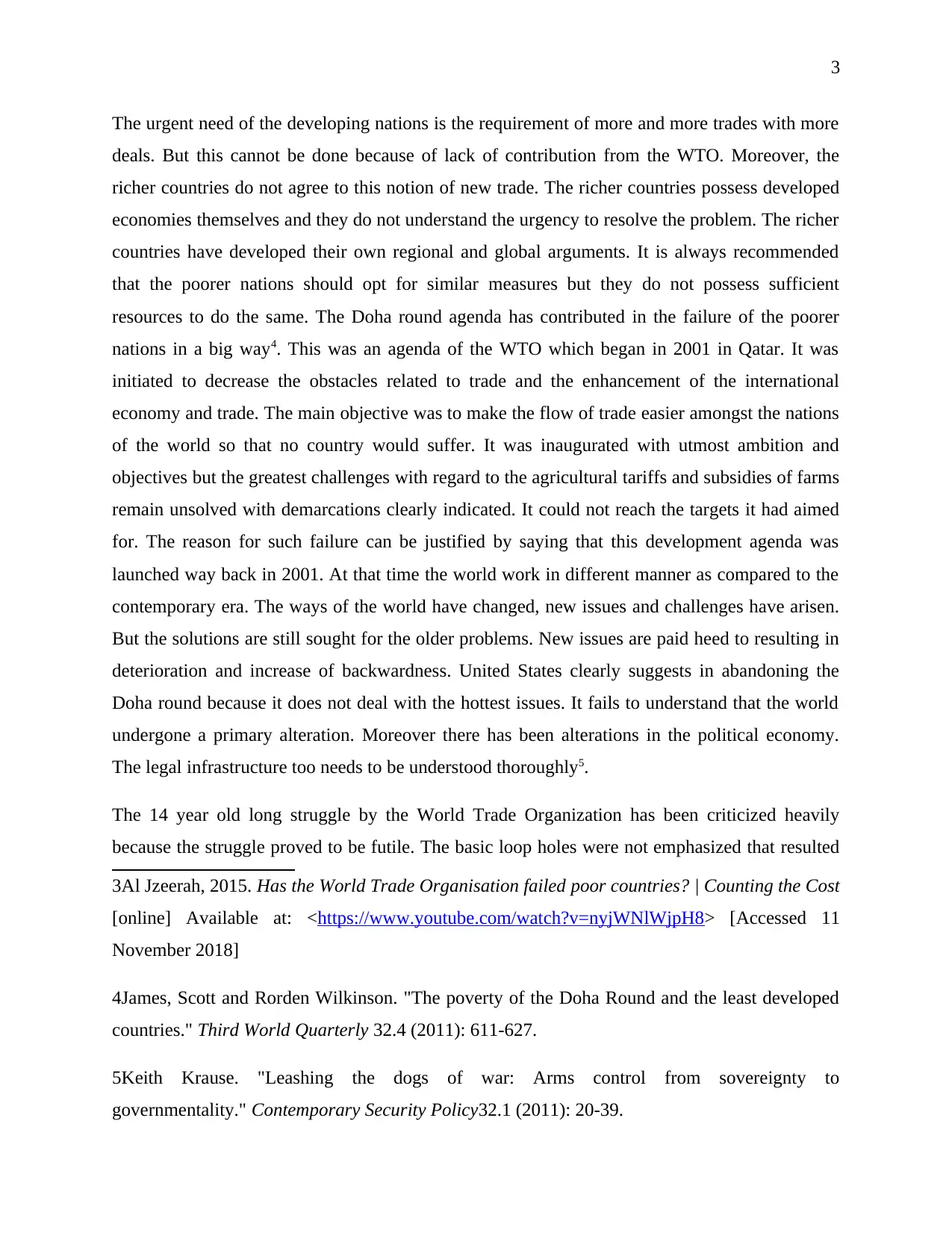
3
The urgent need of the developing nations is the requirement of more and more trades with more
deals. But this cannot be done because of lack of contribution from the WTO. Moreover, the
richer countries do not agree to this notion of new trade. The richer countries possess developed
economies themselves and they do not understand the urgency to resolve the problem. The richer
countries have developed their own regional and global arguments. It is always recommended
that the poorer nations should opt for similar measures but they do not possess sufficient
resources to do the same. The Doha round agenda has contributed in the failure of the poorer
nations in a big way4. This was an agenda of the WTO which began in 2001 in Qatar. It was
initiated to decrease the obstacles related to trade and the enhancement of the international
economy and trade. The main objective was to make the flow of trade easier amongst the nations
of the world so that no country would suffer. It was inaugurated with utmost ambition and
objectives but the greatest challenges with regard to the agricultural tariffs and subsidies of farms
remain unsolved with demarcations clearly indicated. It could not reach the targets it had aimed
for. The reason for such failure can be justified by saying that this development agenda was
launched way back in 2001. At that time the world work in different manner as compared to the
contemporary era. The ways of the world have changed, new issues and challenges have arisen.
But the solutions are still sought for the older problems. New issues are paid heed to resulting in
deterioration and increase of backwardness. United States clearly suggests in abandoning the
Doha round because it does not deal with the hottest issues. It fails to understand that the world
undergone a primary alteration. Moreover there has been alterations in the political economy.
The legal infrastructure too needs to be understood thoroughly5.
The 14 year old long struggle by the World Trade Organization has been criticized heavily
because the struggle proved to be futile. The basic loop holes were not emphasized that resulted
3Al Jzeerah, 2015. Has the World Trade Organisation failed poor countries? | Counting the Cost
[online] Available at: <https://www.youtube.com/watch?v=nyjWNlWjpH8> [Accessed 11
November 2018]
4James, Scott and Rorden Wilkinson. "The poverty of the Doha Round and the least developed
countries." Third World Quarterly 32.4 (2011): 611-627.
5Keith Krause. "Leashing the dogs of war: Arms control from sovereignty to
governmentality." Contemporary Security Policy32.1 (2011): 20-39.
The urgent need of the developing nations is the requirement of more and more trades with more
deals. But this cannot be done because of lack of contribution from the WTO. Moreover, the
richer countries do not agree to this notion of new trade. The richer countries possess developed
economies themselves and they do not understand the urgency to resolve the problem. The richer
countries have developed their own regional and global arguments. It is always recommended
that the poorer nations should opt for similar measures but they do not possess sufficient
resources to do the same. The Doha round agenda has contributed in the failure of the poorer
nations in a big way4. This was an agenda of the WTO which began in 2001 in Qatar. It was
initiated to decrease the obstacles related to trade and the enhancement of the international
economy and trade. The main objective was to make the flow of trade easier amongst the nations
of the world so that no country would suffer. It was inaugurated with utmost ambition and
objectives but the greatest challenges with regard to the agricultural tariffs and subsidies of farms
remain unsolved with demarcations clearly indicated. It could not reach the targets it had aimed
for. The reason for such failure can be justified by saying that this development agenda was
launched way back in 2001. At that time the world work in different manner as compared to the
contemporary era. The ways of the world have changed, new issues and challenges have arisen.
But the solutions are still sought for the older problems. New issues are paid heed to resulting in
deterioration and increase of backwardness. United States clearly suggests in abandoning the
Doha round because it does not deal with the hottest issues. It fails to understand that the world
undergone a primary alteration. Moreover there has been alterations in the political economy.
The legal infrastructure too needs to be understood thoroughly5.
The 14 year old long struggle by the World Trade Organization has been criticized heavily
because the struggle proved to be futile. The basic loop holes were not emphasized that resulted
3Al Jzeerah, 2015. Has the World Trade Organisation failed poor countries? | Counting the Cost
[online] Available at: <https://www.youtube.com/watch?v=nyjWNlWjpH8> [Accessed 11
November 2018]
4James, Scott and Rorden Wilkinson. "The poverty of the Doha Round and the least developed
countries." Third World Quarterly 32.4 (2011): 611-627.
5Keith Krause. "Leashing the dogs of war: Arms control from sovereignty to
governmentality." Contemporary Security Policy32.1 (2011): 20-39.
⊘ This is a preview!⊘
Do you want full access?
Subscribe today to unlock all pages.

Trusted by 1+ million students worldwide
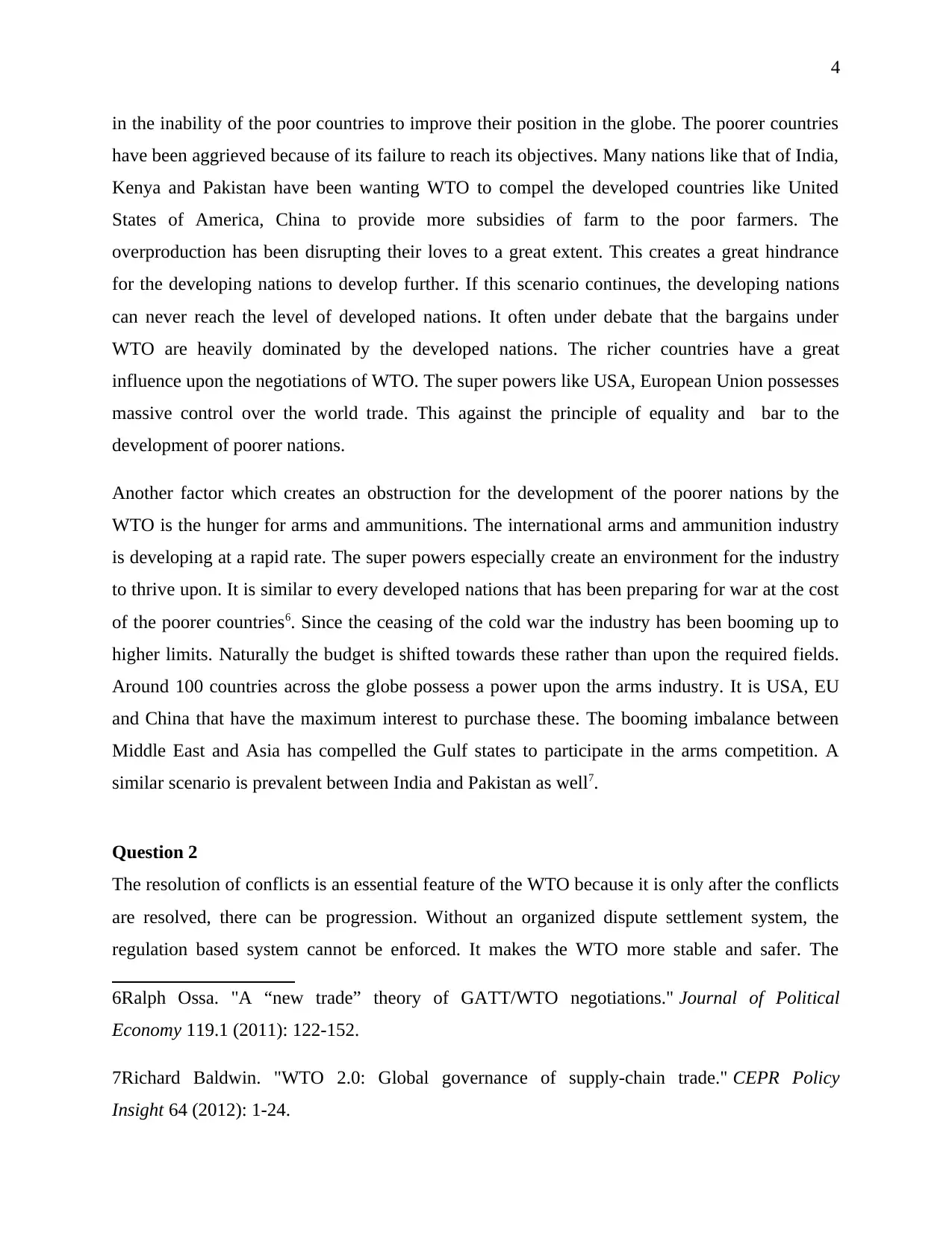
4
in the inability of the poor countries to improve their position in the globe. The poorer countries
have been aggrieved because of its failure to reach its objectives. Many nations like that of India,
Kenya and Pakistan have been wanting WTO to compel the developed countries like United
States of America, China to provide more subsidies of farm to the poor farmers. The
overproduction has been disrupting their loves to a great extent. This creates a great hindrance
for the developing nations to develop further. If this scenario continues, the developing nations
can never reach the level of developed nations. It often under debate that the bargains under
WTO are heavily dominated by the developed nations. The richer countries have a great
influence upon the negotiations of WTO. The super powers like USA, European Union possesses
massive control over the world trade. This against the principle of equality and bar to the
development of poorer nations.
Another factor which creates an obstruction for the development of the poorer nations by the
WTO is the hunger for arms and ammunitions. The international arms and ammunition industry
is developing at a rapid rate. The super powers especially create an environment for the industry
to thrive upon. It is similar to every developed nations that has been preparing for war at the cost
of the poorer countries6. Since the ceasing of the cold war the industry has been booming up to
higher limits. Naturally the budget is shifted towards these rather than upon the required fields.
Around 100 countries across the globe possess a power upon the arms industry. It is USA, EU
and China that have the maximum interest to purchase these. The booming imbalance between
Middle East and Asia has compelled the Gulf states to participate in the arms competition. A
similar scenario is prevalent between India and Pakistan as well7.
Question 2
The resolution of conflicts is an essential feature of the WTO because it is only after the conflicts
are resolved, there can be progression. Without an organized dispute settlement system, the
regulation based system cannot be enforced. It makes the WTO more stable and safer. The
6Ralph Ossa. "A “new trade” theory of GATT/WTO negotiations." Journal of Political
Economy 119.1 (2011): 122-152.
7Richard Baldwin. "WTO 2.0: Global governance of supply-chain trade." CEPR Policy
Insight 64 (2012): 1-24.
in the inability of the poor countries to improve their position in the globe. The poorer countries
have been aggrieved because of its failure to reach its objectives. Many nations like that of India,
Kenya and Pakistan have been wanting WTO to compel the developed countries like United
States of America, China to provide more subsidies of farm to the poor farmers. The
overproduction has been disrupting their loves to a great extent. This creates a great hindrance
for the developing nations to develop further. If this scenario continues, the developing nations
can never reach the level of developed nations. It often under debate that the bargains under
WTO are heavily dominated by the developed nations. The richer countries have a great
influence upon the negotiations of WTO. The super powers like USA, European Union possesses
massive control over the world trade. This against the principle of equality and bar to the
development of poorer nations.
Another factor which creates an obstruction for the development of the poorer nations by the
WTO is the hunger for arms and ammunitions. The international arms and ammunition industry
is developing at a rapid rate. The super powers especially create an environment for the industry
to thrive upon. It is similar to every developed nations that has been preparing for war at the cost
of the poorer countries6. Since the ceasing of the cold war the industry has been booming up to
higher limits. Naturally the budget is shifted towards these rather than upon the required fields.
Around 100 countries across the globe possess a power upon the arms industry. It is USA, EU
and China that have the maximum interest to purchase these. The booming imbalance between
Middle East and Asia has compelled the Gulf states to participate in the arms competition. A
similar scenario is prevalent between India and Pakistan as well7.
Question 2
The resolution of conflicts is an essential feature of the WTO because it is only after the conflicts
are resolved, there can be progression. Without an organized dispute settlement system, the
regulation based system cannot be enforced. It makes the WTO more stable and safer. The
6Ralph Ossa. "A “new trade” theory of GATT/WTO negotiations." Journal of Political
Economy 119.1 (2011): 122-152.
7Richard Baldwin. "WTO 2.0: Global governance of supply-chain trade." CEPR Policy
Insight 64 (2012): 1-24.
Paraphrase This Document
Need a fresh take? Get an instant paraphrase of this document with our AI Paraphraser
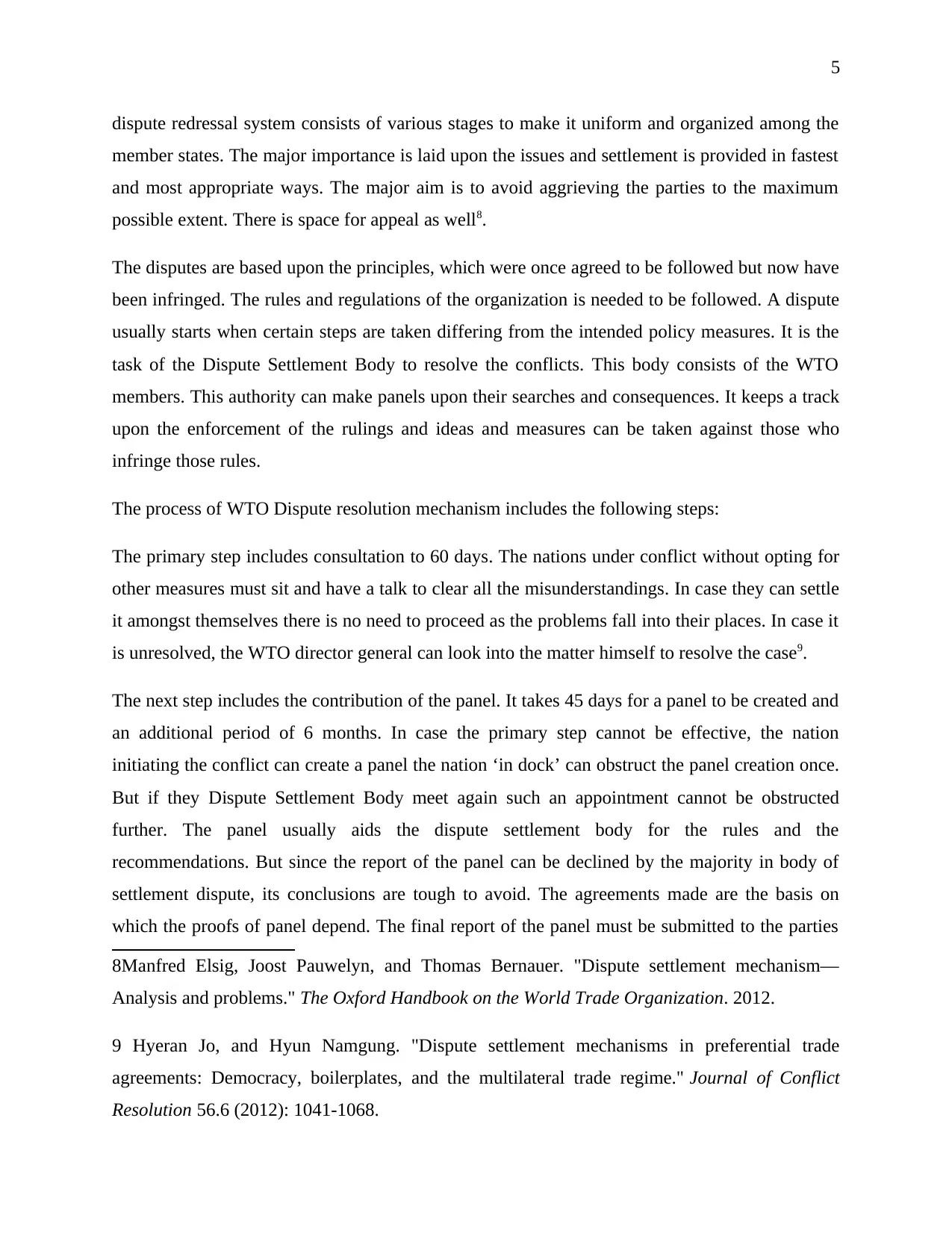
5
dispute redressal system consists of various stages to make it uniform and organized among the
member states. The major importance is laid upon the issues and settlement is provided in fastest
and most appropriate ways. The major aim is to avoid aggrieving the parties to the maximum
possible extent. There is space for appeal as well8.
The disputes are based upon the principles, which were once agreed to be followed but now have
been infringed. The rules and regulations of the organization is needed to be followed. A dispute
usually starts when certain steps are taken differing from the intended policy measures. It is the
task of the Dispute Settlement Body to resolve the conflicts. This body consists of the WTO
members. This authority can make panels upon their searches and consequences. It keeps a track
upon the enforcement of the rulings and ideas and measures can be taken against those who
infringe those rules.
The process of WTO Dispute resolution mechanism includes the following steps:
The primary step includes consultation to 60 days. The nations under conflict without opting for
other measures must sit and have a talk to clear all the misunderstandings. In case they can settle
it amongst themselves there is no need to proceed as the problems fall into their places. In case it
is unresolved, the WTO director general can look into the matter himself to resolve the case9.
The next step includes the contribution of the panel. It takes 45 days for a panel to be created and
an additional period of 6 months. In case the primary step cannot be effective, the nation
initiating the conflict can create a panel the nation ‘in dock’ can obstruct the panel creation once.
But if they Dispute Settlement Body meet again such an appointment cannot be obstructed
further. The panel usually aids the dispute settlement body for the rules and the
recommendations. But since the report of the panel can be declined by the majority in body of
settlement dispute, its conclusions are tough to avoid. The agreements made are the basis on
which the proofs of panel depend. The final report of the panel must be submitted to the parties
8Manfred Elsig, Joost Pauwelyn, and Thomas Bernauer. "Dispute settlement mechanism—
Analysis and problems." The Oxford Handbook on the World Trade Organization. 2012.
9 Hyeran Jo, and Hyun Namgung. "Dispute settlement mechanisms in preferential trade
agreements: Democracy, boilerplates, and the multilateral trade regime." Journal of Conflict
Resolution 56.6 (2012): 1041-1068.
dispute redressal system consists of various stages to make it uniform and organized among the
member states. The major importance is laid upon the issues and settlement is provided in fastest
and most appropriate ways. The major aim is to avoid aggrieving the parties to the maximum
possible extent. There is space for appeal as well8.
The disputes are based upon the principles, which were once agreed to be followed but now have
been infringed. The rules and regulations of the organization is needed to be followed. A dispute
usually starts when certain steps are taken differing from the intended policy measures. It is the
task of the Dispute Settlement Body to resolve the conflicts. This body consists of the WTO
members. This authority can make panels upon their searches and consequences. It keeps a track
upon the enforcement of the rulings and ideas and measures can be taken against those who
infringe those rules.
The process of WTO Dispute resolution mechanism includes the following steps:
The primary step includes consultation to 60 days. The nations under conflict without opting for
other measures must sit and have a talk to clear all the misunderstandings. In case they can settle
it amongst themselves there is no need to proceed as the problems fall into their places. In case it
is unresolved, the WTO director general can look into the matter himself to resolve the case9.
The next step includes the contribution of the panel. It takes 45 days for a panel to be created and
an additional period of 6 months. In case the primary step cannot be effective, the nation
initiating the conflict can create a panel the nation ‘in dock’ can obstruct the panel creation once.
But if they Dispute Settlement Body meet again such an appointment cannot be obstructed
further. The panel usually aids the dispute settlement body for the rules and the
recommendations. But since the report of the panel can be declined by the majority in body of
settlement dispute, its conclusions are tough to avoid. The agreements made are the basis on
which the proofs of panel depend. The final report of the panel must be submitted to the parties
8Manfred Elsig, Joost Pauwelyn, and Thomas Bernauer. "Dispute settlement mechanism—
Analysis and problems." The Oxford Handbook on the World Trade Organization. 2012.
9 Hyeran Jo, and Hyun Namgung. "Dispute settlement mechanisms in preferential trade
agreements: Democracy, boilerplates, and the multilateral trade regime." Journal of Conflict
Resolution 56.6 (2012): 1041-1068.
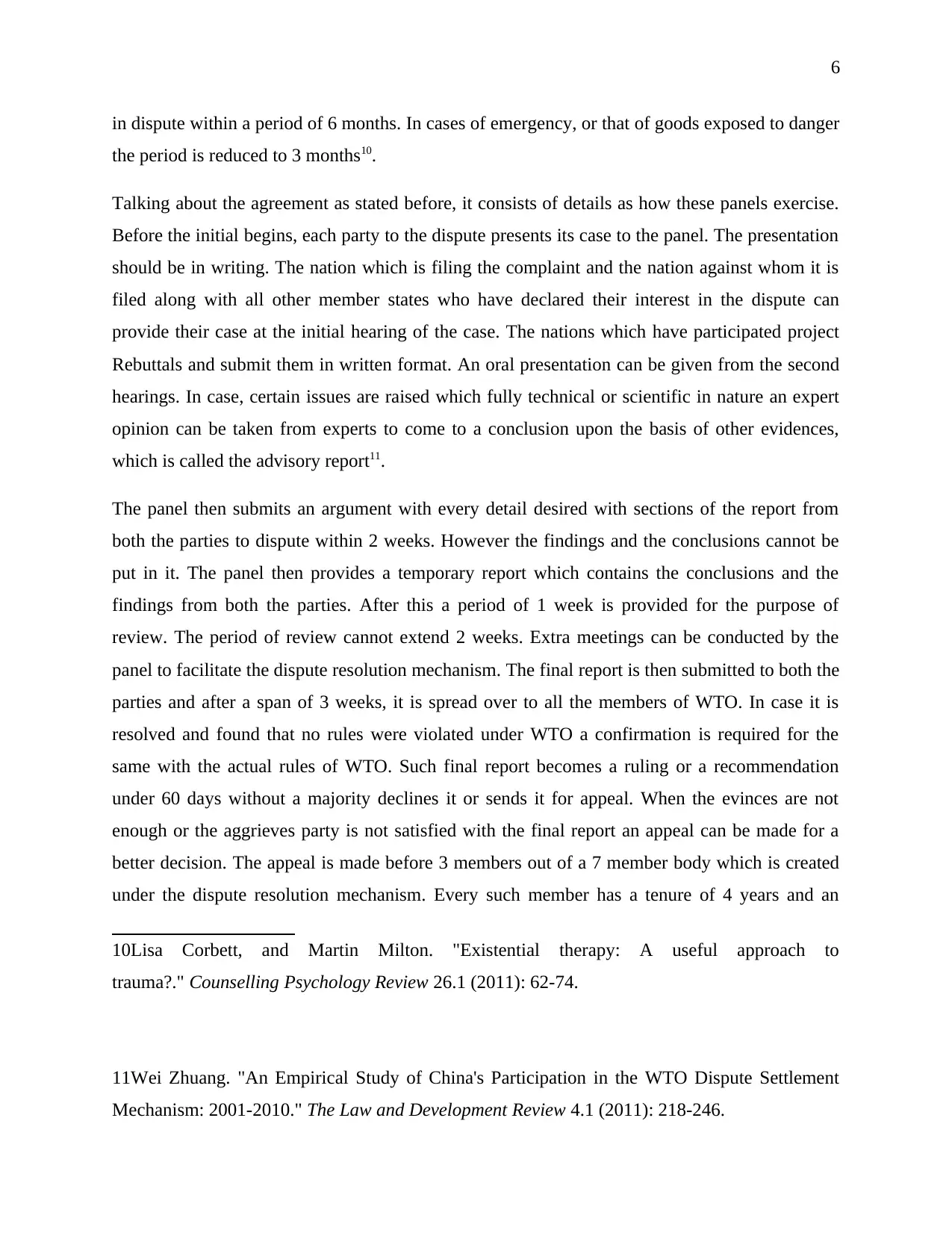
6
in dispute within a period of 6 months. In cases of emergency, or that of goods exposed to danger
the period is reduced to 3 months10.
Talking about the agreement as stated before, it consists of details as how these panels exercise.
Before the initial begins, each party to the dispute presents its case to the panel. The presentation
should be in writing. The nation which is filing the complaint and the nation against whom it is
filed along with all other member states who have declared their interest in the dispute can
provide their case at the initial hearing of the case. The nations which have participated project
Rebuttals and submit them in written format. An oral presentation can be given from the second
hearings. In case, certain issues are raised which fully technical or scientific in nature an expert
opinion can be taken from experts to come to a conclusion upon the basis of other evidences,
which is called the advisory report11.
The panel then submits an argument with every detail desired with sections of the report from
both the parties to dispute within 2 weeks. However the findings and the conclusions cannot be
put in it. The panel then provides a temporary report which contains the conclusions and the
findings from both the parties. After this a period of 1 week is provided for the purpose of
review. The period of review cannot extend 2 weeks. Extra meetings can be conducted by the
panel to facilitate the dispute resolution mechanism. The final report is then submitted to both the
parties and after a span of 3 weeks, it is spread over to all the members of WTO. In case it is
resolved and found that no rules were violated under WTO a confirmation is required for the
same with the actual rules of WTO. Such final report becomes a ruling or a recommendation
under 60 days without a majority declines it or sends it for appeal. When the evinces are not
enough or the aggrieves party is not satisfied with the final report an appeal can be made for a
better decision. The appeal is made before 3 members out of a 7 member body which is created
under the dispute resolution mechanism. Every such member has a tenure of 4 years and an
10Lisa Corbett, and Martin Milton. "Existential therapy: A useful approach to
trauma?." Counselling Psychology Review 26.1 (2011): 62-74.
11Wei Zhuang. "An Empirical Study of China's Participation in the WTO Dispute Settlement
Mechanism: 2001-2010." The Law and Development Review 4.1 (2011): 218-246.
in dispute within a period of 6 months. In cases of emergency, or that of goods exposed to danger
the period is reduced to 3 months10.
Talking about the agreement as stated before, it consists of details as how these panels exercise.
Before the initial begins, each party to the dispute presents its case to the panel. The presentation
should be in writing. The nation which is filing the complaint and the nation against whom it is
filed along with all other member states who have declared their interest in the dispute can
provide their case at the initial hearing of the case. The nations which have participated project
Rebuttals and submit them in written format. An oral presentation can be given from the second
hearings. In case, certain issues are raised which fully technical or scientific in nature an expert
opinion can be taken from experts to come to a conclusion upon the basis of other evidences,
which is called the advisory report11.
The panel then submits an argument with every detail desired with sections of the report from
both the parties to dispute within 2 weeks. However the findings and the conclusions cannot be
put in it. The panel then provides a temporary report which contains the conclusions and the
findings from both the parties. After this a period of 1 week is provided for the purpose of
review. The period of review cannot extend 2 weeks. Extra meetings can be conducted by the
panel to facilitate the dispute resolution mechanism. The final report is then submitted to both the
parties and after a span of 3 weeks, it is spread over to all the members of WTO. In case it is
resolved and found that no rules were violated under WTO a confirmation is required for the
same with the actual rules of WTO. Such final report becomes a ruling or a recommendation
under 60 days without a majority declines it or sends it for appeal. When the evinces are not
enough or the aggrieves party is not satisfied with the final report an appeal can be made for a
better decision. The appeal is made before 3 members out of a 7 member body which is created
under the dispute resolution mechanism. Every such member has a tenure of 4 years and an
10Lisa Corbett, and Martin Milton. "Existential therapy: A useful approach to
trauma?." Counselling Psychology Review 26.1 (2011): 62-74.
11Wei Zhuang. "An Empirical Study of China's Participation in the WTO Dispute Settlement
Mechanism: 2001-2010." The Law and Development Review 4.1 (2011): 218-246.
⊘ This is a preview!⊘
Do you want full access?
Subscribe today to unlock all pages.

Trusted by 1+ million students worldwide
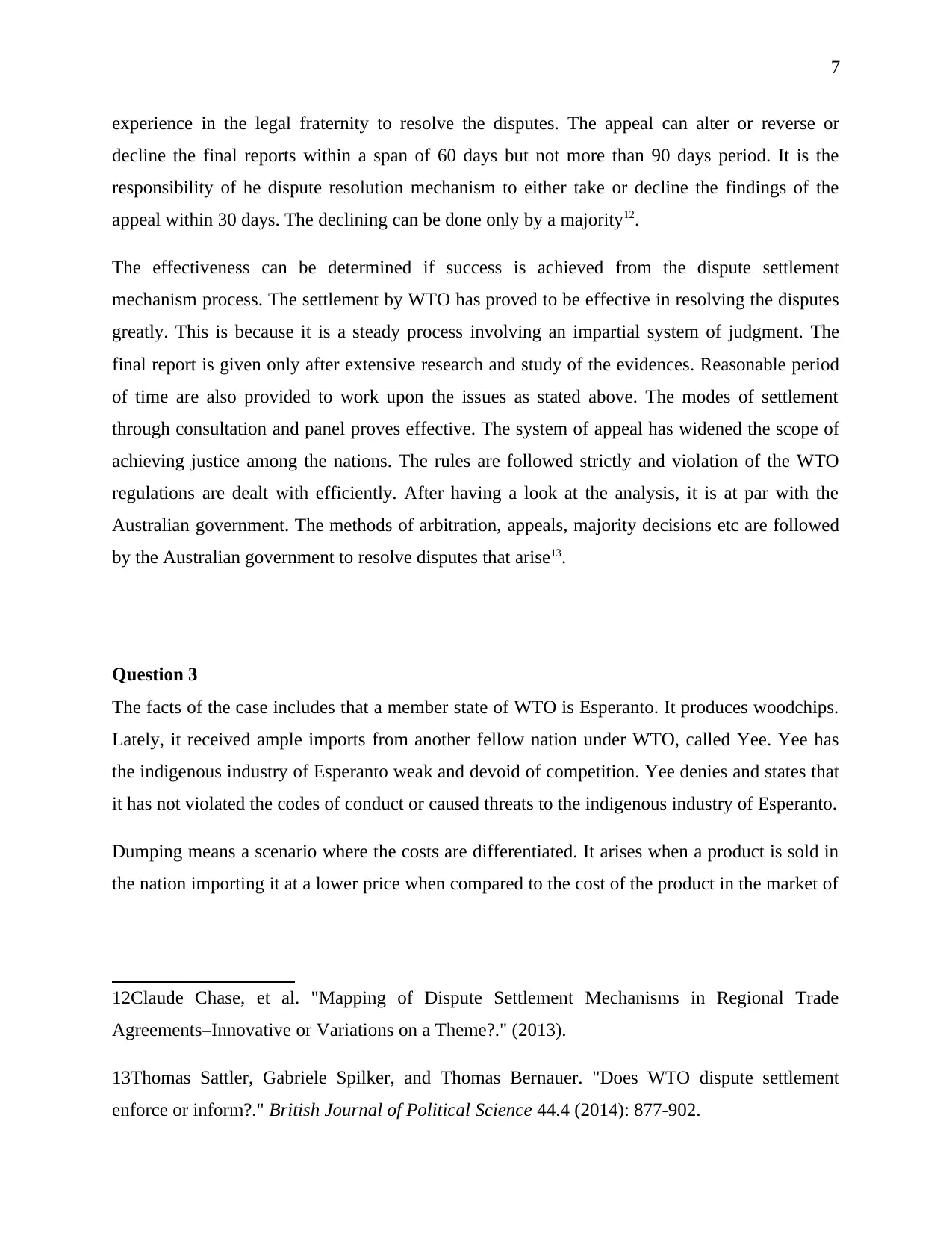
7
experience in the legal fraternity to resolve the disputes. The appeal can alter or reverse or
decline the final reports within a span of 60 days but not more than 90 days period. It is the
responsibility of he dispute resolution mechanism to either take or decline the findings of the
appeal within 30 days. The declining can be done only by a majority12.
The effectiveness can be determined if success is achieved from the dispute settlement
mechanism process. The settlement by WTO has proved to be effective in resolving the disputes
greatly. This is because it is a steady process involving an impartial system of judgment. The
final report is given only after extensive research and study of the evidences. Reasonable period
of time are also provided to work upon the issues as stated above. The modes of settlement
through consultation and panel proves effective. The system of appeal has widened the scope of
achieving justice among the nations. The rules are followed strictly and violation of the WTO
regulations are dealt with efficiently. After having a look at the analysis, it is at par with the
Australian government. The methods of arbitration, appeals, majority decisions etc are followed
by the Australian government to resolve disputes that arise13.
Question 3
The facts of the case includes that a member state of WTO is Esperanto. It produces woodchips.
Lately, it received ample imports from another fellow nation under WTO, called Yee. Yee has
the indigenous industry of Esperanto weak and devoid of competition. Yee denies and states that
it has not violated the codes of conduct or caused threats to the indigenous industry of Esperanto.
Dumping means a scenario where the costs are differentiated. It arises when a product is sold in
the nation importing it at a lower price when compared to the cost of the product in the market of
12Claude Chase, et al. "Mapping of Dispute Settlement Mechanisms in Regional Trade
Agreements–Innovative or Variations on a Theme?." (2013).
13Thomas Sattler, Gabriele Spilker, and Thomas Bernauer. "Does WTO dispute settlement
enforce or inform?." British Journal of Political Science 44.4 (2014): 877-902.
experience in the legal fraternity to resolve the disputes. The appeal can alter or reverse or
decline the final reports within a span of 60 days but not more than 90 days period. It is the
responsibility of he dispute resolution mechanism to either take or decline the findings of the
appeal within 30 days. The declining can be done only by a majority12.
The effectiveness can be determined if success is achieved from the dispute settlement
mechanism process. The settlement by WTO has proved to be effective in resolving the disputes
greatly. This is because it is a steady process involving an impartial system of judgment. The
final report is given only after extensive research and study of the evidences. Reasonable period
of time are also provided to work upon the issues as stated above. The modes of settlement
through consultation and panel proves effective. The system of appeal has widened the scope of
achieving justice among the nations. The rules are followed strictly and violation of the WTO
regulations are dealt with efficiently. After having a look at the analysis, it is at par with the
Australian government. The methods of arbitration, appeals, majority decisions etc are followed
by the Australian government to resolve disputes that arise13.
Question 3
The facts of the case includes that a member state of WTO is Esperanto. It produces woodchips.
Lately, it received ample imports from another fellow nation under WTO, called Yee. Yee has
the indigenous industry of Esperanto weak and devoid of competition. Yee denies and states that
it has not violated the codes of conduct or caused threats to the indigenous industry of Esperanto.
Dumping means a scenario where the costs are differentiated. It arises when a product is sold in
the nation importing it at a lower price when compared to the cost of the product in the market of
12Claude Chase, et al. "Mapping of Dispute Settlement Mechanisms in Regional Trade
Agreements–Innovative or Variations on a Theme?." (2013).
13Thomas Sattler, Gabriele Spilker, and Thomas Bernauer. "Does WTO dispute settlement
enforce or inform?." British Journal of Political Science 44.4 (2014): 877-902.
Paraphrase This Document
Need a fresh take? Get an instant paraphrase of this document with our AI Paraphraser
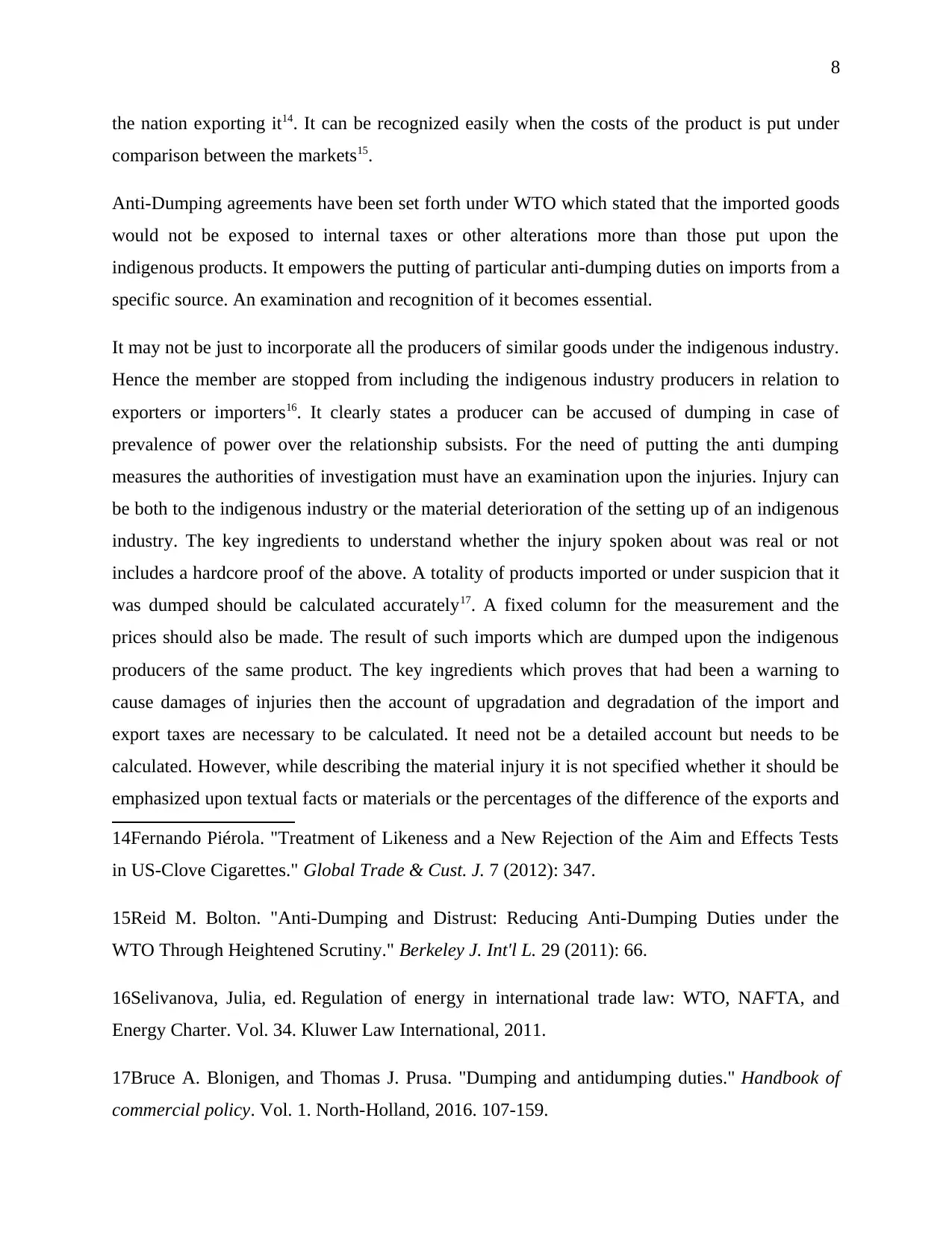
8
the nation exporting it14. It can be recognized easily when the costs of the product is put under
comparison between the markets15.
Anti-Dumping agreements have been set forth under WTO which stated that the imported goods
would not be exposed to internal taxes or other alterations more than those put upon the
indigenous products. It empowers the putting of particular anti-dumping duties on imports from a
specific source. An examination and recognition of it becomes essential.
It may not be just to incorporate all the producers of similar goods under the indigenous industry.
Hence the member are stopped from including the indigenous industry producers in relation to
exporters or importers16. It clearly states a producer can be accused of dumping in case of
prevalence of power over the relationship subsists. For the need of putting the anti dumping
measures the authorities of investigation must have an examination upon the injuries. Injury can
be both to the indigenous industry or the material deterioration of the setting up of an indigenous
industry. The key ingredients to understand whether the injury spoken about was real or not
includes a hardcore proof of the above. A totality of products imported or under suspicion that it
was dumped should be calculated accurately17. A fixed column for the measurement and the
prices should also be made. The result of such imports which are dumped upon the indigenous
producers of the same product. The key ingredients which proves that had been a warning to
cause damages of injuries then the account of upgradation and degradation of the import and
export taxes are necessary to be calculated. It need not be a detailed account but needs to be
calculated. However, while describing the material injury it is not specified whether it should be
emphasized upon textual facts or materials or the percentages of the difference of the exports and
14Fernando Piérola. "Treatment of Likeness and a New Rejection of the Aim and Effects Tests
in US-Clove Cigarettes." Global Trade & Cust. J. 7 (2012): 347.
15Reid M. Bolton. "Anti-Dumping and Distrust: Reducing Anti-Dumping Duties under the
WTO Through Heightened Scrutiny." Berkeley J. Int'l L. 29 (2011): 66.
16Selivanova, Julia, ed. Regulation of energy in international trade law: WTO, NAFTA, and
Energy Charter. Vol. 34. Kluwer Law International, 2011.
17Bruce A. Blonigen, and Thomas J. Prusa. "Dumping and antidumping duties." Handbook of
commercial policy. Vol. 1. North-Holland, 2016. 107-159.
the nation exporting it14. It can be recognized easily when the costs of the product is put under
comparison between the markets15.
Anti-Dumping agreements have been set forth under WTO which stated that the imported goods
would not be exposed to internal taxes or other alterations more than those put upon the
indigenous products. It empowers the putting of particular anti-dumping duties on imports from a
specific source. An examination and recognition of it becomes essential.
It may not be just to incorporate all the producers of similar goods under the indigenous industry.
Hence the member are stopped from including the indigenous industry producers in relation to
exporters or importers16. It clearly states a producer can be accused of dumping in case of
prevalence of power over the relationship subsists. For the need of putting the anti dumping
measures the authorities of investigation must have an examination upon the injuries. Injury can
be both to the indigenous industry or the material deterioration of the setting up of an indigenous
industry. The key ingredients to understand whether the injury spoken about was real or not
includes a hardcore proof of the above. A totality of products imported or under suspicion that it
was dumped should be calculated accurately17. A fixed column for the measurement and the
prices should also be made. The result of such imports which are dumped upon the indigenous
producers of the same product. The key ingredients which proves that had been a warning to
cause damages of injuries then the account of upgradation and degradation of the import and
export taxes are necessary to be calculated. It need not be a detailed account but needs to be
calculated. However, while describing the material injury it is not specified whether it should be
emphasized upon textual facts or materials or the percentages of the difference of the exports and
14Fernando Piérola. "Treatment of Likeness and a New Rejection of the Aim and Effects Tests
in US-Clove Cigarettes." Global Trade & Cust. J. 7 (2012): 347.
15Reid M. Bolton. "Anti-Dumping and Distrust: Reducing Anti-Dumping Duties under the
WTO Through Heightened Scrutiny." Berkeley J. Int'l L. 29 (2011): 66.
16Selivanova, Julia, ed. Regulation of energy in international trade law: WTO, NAFTA, and
Energy Charter. Vol. 34. Kluwer Law International, 2011.
17Bruce A. Blonigen, and Thomas J. Prusa. "Dumping and antidumping duties." Handbook of
commercial policy. Vol. 1. North-Holland, 2016. 107-159.
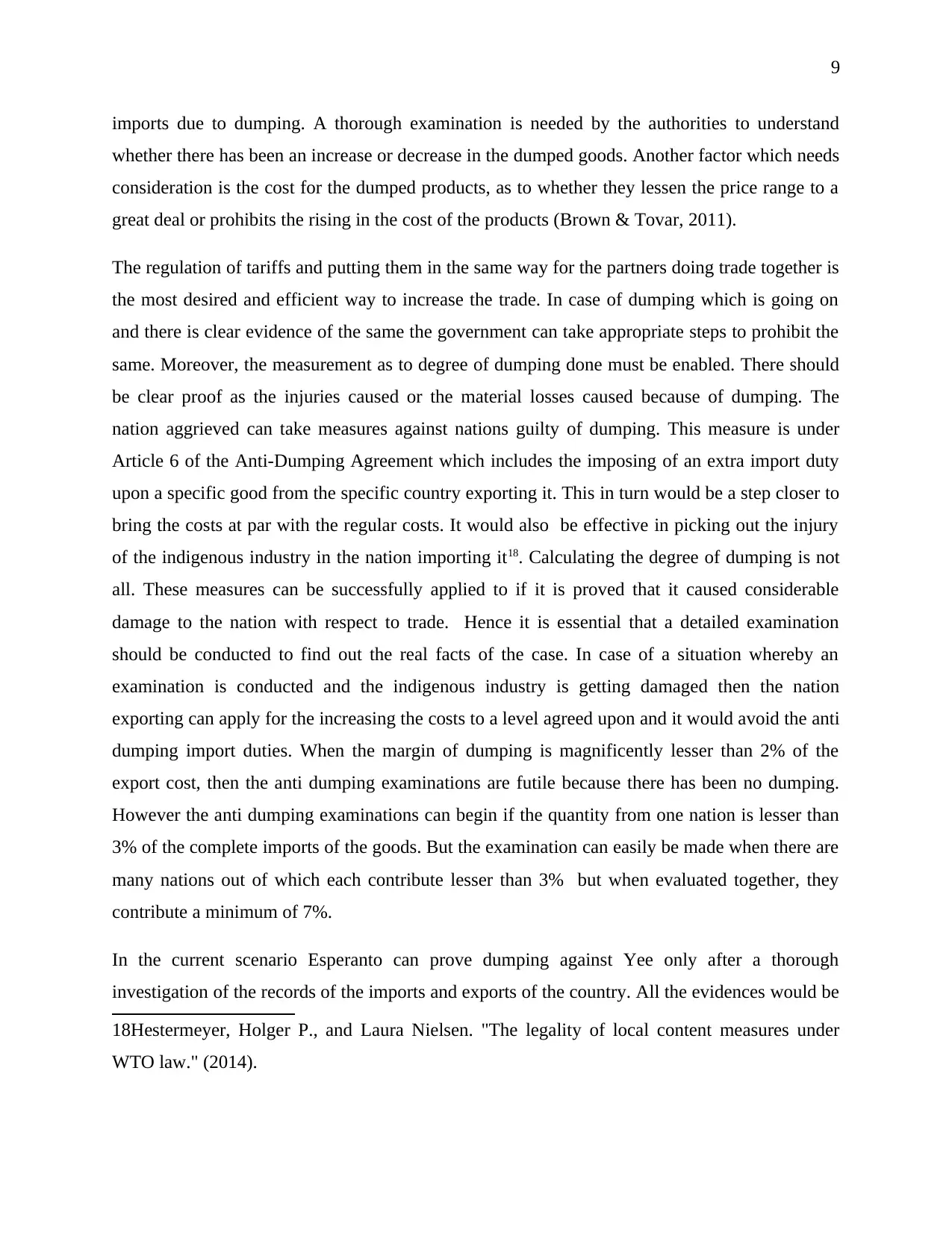
9
imports due to dumping. A thorough examination is needed by the authorities to understand
whether there has been an increase or decrease in the dumped goods. Another factor which needs
consideration is the cost for the dumped products, as to whether they lessen the price range to a
great deal or prohibits the rising in the cost of the products (Brown & Tovar, 2011).
The regulation of tariffs and putting them in the same way for the partners doing trade together is
the most desired and efficient way to increase the trade. In case of dumping which is going on
and there is clear evidence of the same the government can take appropriate steps to prohibit the
same. Moreover, the measurement as to degree of dumping done must be enabled. There should
be clear proof as the injuries caused or the material losses caused because of dumping. The
nation aggrieved can take measures against nations guilty of dumping. This measure is under
Article 6 of the Anti-Dumping Agreement which includes the imposing of an extra import duty
upon a specific good from the specific country exporting it. This in turn would be a step closer to
bring the costs at par with the regular costs. It would also be effective in picking out the injury
of the indigenous industry in the nation importing it18. Calculating the degree of dumping is not
all. These measures can be successfully applied to if it is proved that it caused considerable
damage to the nation with respect to trade. Hence it is essential that a detailed examination
should be conducted to find out the real facts of the case. In case of a situation whereby an
examination is conducted and the indigenous industry is getting damaged then the nation
exporting can apply for the increasing the costs to a level agreed upon and it would avoid the anti
dumping import duties. When the margin of dumping is magnificently lesser than 2% of the
export cost, then the anti dumping examinations are futile because there has been no dumping.
However the anti dumping examinations can begin if the quantity from one nation is lesser than
3% of the complete imports of the goods. But the examination can easily be made when there are
many nations out of which each contribute lesser than 3% but when evaluated together, they
contribute a minimum of 7%.
In the current scenario Esperanto can prove dumping against Yee only after a thorough
investigation of the records of the imports and exports of the country. All the evidences would be
18Hestermeyer, Holger P., and Laura Nielsen. "The legality of local content measures under
WTO law." (2014).
imports due to dumping. A thorough examination is needed by the authorities to understand
whether there has been an increase or decrease in the dumped goods. Another factor which needs
consideration is the cost for the dumped products, as to whether they lessen the price range to a
great deal or prohibits the rising in the cost of the products (Brown & Tovar, 2011).
The regulation of tariffs and putting them in the same way for the partners doing trade together is
the most desired and efficient way to increase the trade. In case of dumping which is going on
and there is clear evidence of the same the government can take appropriate steps to prohibit the
same. Moreover, the measurement as to degree of dumping done must be enabled. There should
be clear proof as the injuries caused or the material losses caused because of dumping. The
nation aggrieved can take measures against nations guilty of dumping. This measure is under
Article 6 of the Anti-Dumping Agreement which includes the imposing of an extra import duty
upon a specific good from the specific country exporting it. This in turn would be a step closer to
bring the costs at par with the regular costs. It would also be effective in picking out the injury
of the indigenous industry in the nation importing it18. Calculating the degree of dumping is not
all. These measures can be successfully applied to if it is proved that it caused considerable
damage to the nation with respect to trade. Hence it is essential that a detailed examination
should be conducted to find out the real facts of the case. In case of a situation whereby an
examination is conducted and the indigenous industry is getting damaged then the nation
exporting can apply for the increasing the costs to a level agreed upon and it would avoid the anti
dumping import duties. When the margin of dumping is magnificently lesser than 2% of the
export cost, then the anti dumping examinations are futile because there has been no dumping.
However the anti dumping examinations can begin if the quantity from one nation is lesser than
3% of the complete imports of the goods. But the examination can easily be made when there are
many nations out of which each contribute lesser than 3% but when evaluated together, they
contribute a minimum of 7%.
In the current scenario Esperanto can prove dumping against Yee only after a thorough
investigation of the records of the imports and exports of the country. All the evidences would be
18Hestermeyer, Holger P., and Laura Nielsen. "The legality of local content measures under
WTO law." (2014).
⊘ This is a preview!⊘
Do you want full access?
Subscribe today to unlock all pages.

Trusted by 1+ million students worldwide
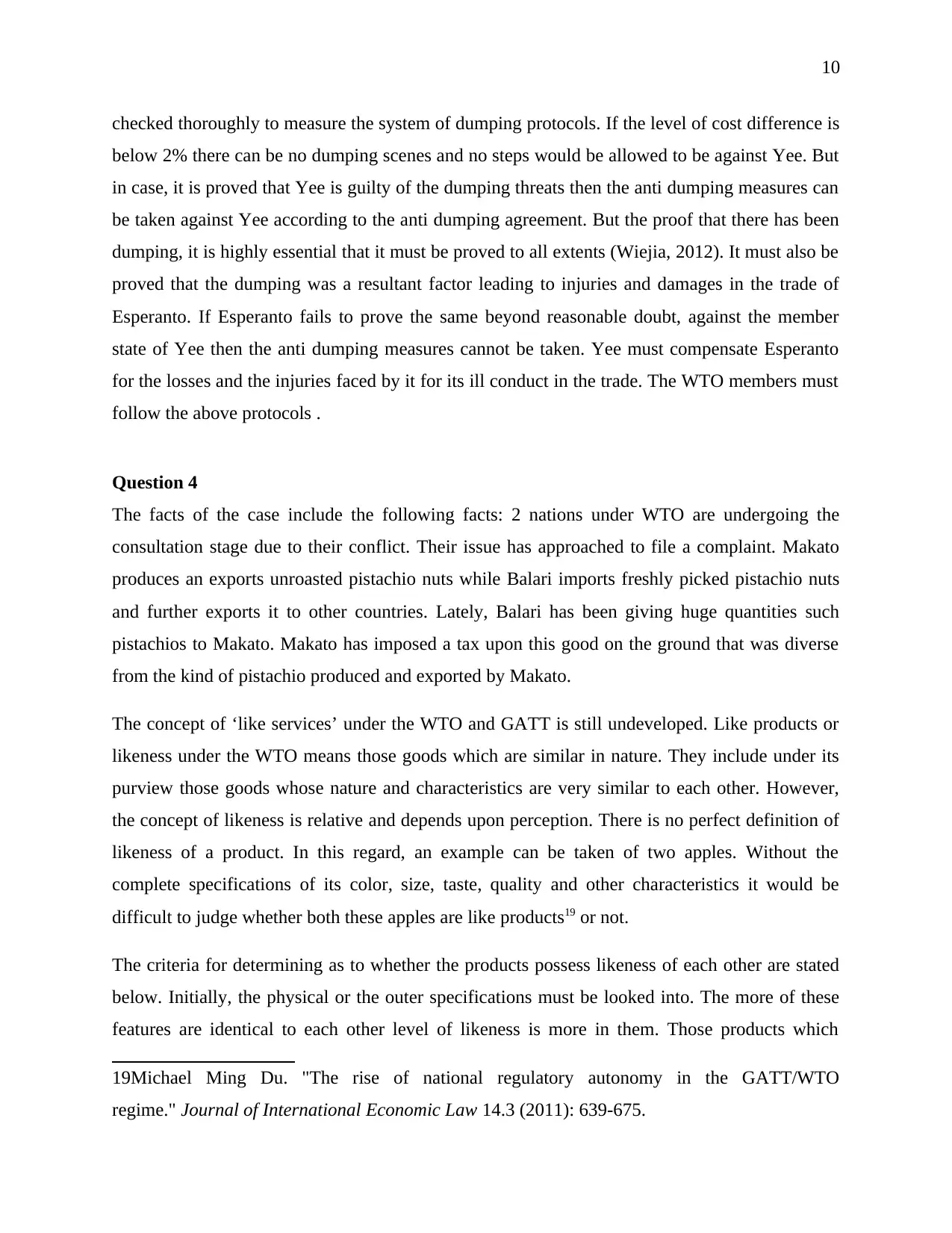
10
checked thoroughly to measure the system of dumping protocols. If the level of cost difference is
below 2% there can be no dumping scenes and no steps would be allowed to be against Yee. But
in case, it is proved that Yee is guilty of the dumping threats then the anti dumping measures can
be taken against Yee according to the anti dumping agreement. But the proof that there has been
dumping, it is highly essential that it must be proved to all extents (Wiejia, 2012). It must also be
proved that the dumping was a resultant factor leading to injuries and damages in the trade of
Esperanto. If Esperanto fails to prove the same beyond reasonable doubt, against the member
state of Yee then the anti dumping measures cannot be taken. Yee must compensate Esperanto
for the losses and the injuries faced by it for its ill conduct in the trade. The WTO members must
follow the above protocols .
Question 4
The facts of the case include the following facts: 2 nations under WTO are undergoing the
consultation stage due to their conflict. Their issue has approached to file a complaint. Makato
produces an exports unroasted pistachio nuts while Balari imports freshly picked pistachio nuts
and further exports it to other countries. Lately, Balari has been giving huge quantities such
pistachios to Makato. Makato has imposed a tax upon this good on the ground that was diverse
from the kind of pistachio produced and exported by Makato.
The concept of ‘like services’ under the WTO and GATT is still undeveloped. Like products or
likeness under the WTO means those goods which are similar in nature. They include under its
purview those goods whose nature and characteristics are very similar to each other. However,
the concept of likeness is relative and depends upon perception. There is no perfect definition of
likeness of a product. In this regard, an example can be taken of two apples. Without the
complete specifications of its color, size, taste, quality and other characteristics it would be
difficult to judge whether both these apples are like products19 or not.
The criteria for determining as to whether the products possess likeness of each other are stated
below. Initially, the physical or the outer specifications must be looked into. The more of these
features are identical to each other level of likeness is more in them. Those products which
19Michael Ming Du. "The rise of national regulatory autonomy in the GATT/WTO
regime." Journal of International Economic Law 14.3 (2011): 639-675.
checked thoroughly to measure the system of dumping protocols. If the level of cost difference is
below 2% there can be no dumping scenes and no steps would be allowed to be against Yee. But
in case, it is proved that Yee is guilty of the dumping threats then the anti dumping measures can
be taken against Yee according to the anti dumping agreement. But the proof that there has been
dumping, it is highly essential that it must be proved to all extents (Wiejia, 2012). It must also be
proved that the dumping was a resultant factor leading to injuries and damages in the trade of
Esperanto. If Esperanto fails to prove the same beyond reasonable doubt, against the member
state of Yee then the anti dumping measures cannot be taken. Yee must compensate Esperanto
for the losses and the injuries faced by it for its ill conduct in the trade. The WTO members must
follow the above protocols .
Question 4
The facts of the case include the following facts: 2 nations under WTO are undergoing the
consultation stage due to their conflict. Their issue has approached to file a complaint. Makato
produces an exports unroasted pistachio nuts while Balari imports freshly picked pistachio nuts
and further exports it to other countries. Lately, Balari has been giving huge quantities such
pistachios to Makato. Makato has imposed a tax upon this good on the ground that was diverse
from the kind of pistachio produced and exported by Makato.
The concept of ‘like services’ under the WTO and GATT is still undeveloped. Like products or
likeness under the WTO means those goods which are similar in nature. They include under its
purview those goods whose nature and characteristics are very similar to each other. However,
the concept of likeness is relative and depends upon perception. There is no perfect definition of
likeness of a product. In this regard, an example can be taken of two apples. Without the
complete specifications of its color, size, taste, quality and other characteristics it would be
difficult to judge whether both these apples are like products19 or not.
The criteria for determining as to whether the products possess likeness of each other are stated
below. Initially, the physical or the outer specifications must be looked into. The more of these
features are identical to each other level of likeness is more in them. Those products which
19Michael Ming Du. "The rise of national regulatory autonomy in the GATT/WTO
regime." Journal of International Economic Law 14.3 (2011): 639-675.
Paraphrase This Document
Need a fresh take? Get an instant paraphrase of this document with our AI Paraphraser
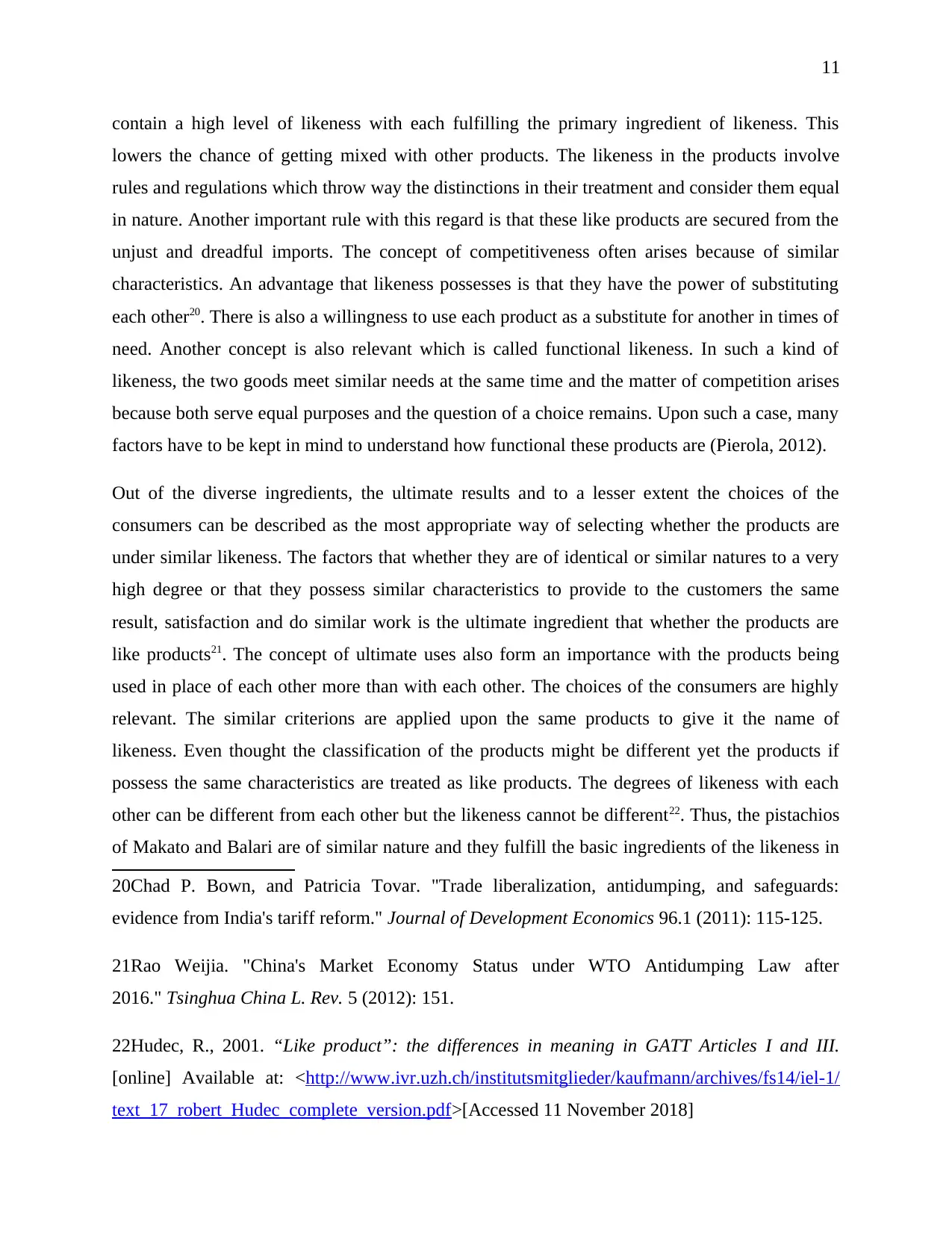
11
contain a high level of likeness with each fulfilling the primary ingredient of likeness. This
lowers the chance of getting mixed with other products. The likeness in the products involve
rules and regulations which throw way the distinctions in their treatment and consider them equal
in nature. Another important rule with this regard is that these like products are secured from the
unjust and dreadful imports. The concept of competitiveness often arises because of similar
characteristics. An advantage that likeness possesses is that they have the power of substituting
each other20. There is also a willingness to use each product as a substitute for another in times of
need. Another concept is also relevant which is called functional likeness. In such a kind of
likeness, the two goods meet similar needs at the same time and the matter of competition arises
because both serve equal purposes and the question of a choice remains. Upon such a case, many
factors have to be kept in mind to understand how functional these products are (Pierola, 2012).
Out of the diverse ingredients, the ultimate results and to a lesser extent the choices of the
consumers can be described as the most appropriate way of selecting whether the products are
under similar likeness. The factors that whether they are of identical or similar natures to a very
high degree or that they possess similar characteristics to provide to the customers the same
result, satisfaction and do similar work is the ultimate ingredient that whether the products are
like products21. The concept of ultimate uses also form an importance with the products being
used in place of each other more than with each other. The choices of the consumers are highly
relevant. The similar criterions are applied upon the same products to give it the name of
likeness. Even thought the classification of the products might be different yet the products if
possess the same characteristics are treated as like products. The degrees of likeness with each
other can be different from each other but the likeness cannot be different22. Thus, the pistachios
of Makato and Balari are of similar nature and they fulfill the basic ingredients of the likeness in
20Chad P. Bown, and Patricia Tovar. "Trade liberalization, antidumping, and safeguards:
evidence from India's tariff reform." Journal of Development Economics 96.1 (2011): 115-125.
21Rao Weijia. "China's Market Economy Status under WTO Antidumping Law after
2016." Tsinghua China L. Rev. 5 (2012): 151.
22Hudec, R., 2001. “Like product”: the differences in meaning in GATT Articles I and III.
[online] Available at: <http://www.ivr.uzh.ch/institutsmitglieder/kaufmann/archives/fs14/iel-1/
text_17_robert_Hudec_complete_version.pdf>[Accessed 11 November 2018]
contain a high level of likeness with each fulfilling the primary ingredient of likeness. This
lowers the chance of getting mixed with other products. The likeness in the products involve
rules and regulations which throw way the distinctions in their treatment and consider them equal
in nature. Another important rule with this regard is that these like products are secured from the
unjust and dreadful imports. The concept of competitiveness often arises because of similar
characteristics. An advantage that likeness possesses is that they have the power of substituting
each other20. There is also a willingness to use each product as a substitute for another in times of
need. Another concept is also relevant which is called functional likeness. In such a kind of
likeness, the two goods meet similar needs at the same time and the matter of competition arises
because both serve equal purposes and the question of a choice remains. Upon such a case, many
factors have to be kept in mind to understand how functional these products are (Pierola, 2012).
Out of the diverse ingredients, the ultimate results and to a lesser extent the choices of the
consumers can be described as the most appropriate way of selecting whether the products are
under similar likeness. The factors that whether they are of identical or similar natures to a very
high degree or that they possess similar characteristics to provide to the customers the same
result, satisfaction and do similar work is the ultimate ingredient that whether the products are
like products21. The concept of ultimate uses also form an importance with the products being
used in place of each other more than with each other. The choices of the consumers are highly
relevant. The similar criterions are applied upon the same products to give it the name of
likeness. Even thought the classification of the products might be different yet the products if
possess the same characteristics are treated as like products. The degrees of likeness with each
other can be different from each other but the likeness cannot be different22. Thus, the pistachios
of Makato and Balari are of similar nature and they fulfill the basic ingredients of the likeness in
20Chad P. Bown, and Patricia Tovar. "Trade liberalization, antidumping, and safeguards:
evidence from India's tariff reform." Journal of Development Economics 96.1 (2011): 115-125.
21Rao Weijia. "China's Market Economy Status under WTO Antidumping Law after
2016." Tsinghua China L. Rev. 5 (2012): 151.
22Hudec, R., 2001. “Like product”: the differences in meaning in GATT Articles I and III.
[online] Available at: <http://www.ivr.uzh.ch/institutsmitglieder/kaufmann/archives/fs14/iel-1/
text_17_robert_Hudec_complete_version.pdf>[Accessed 11 November 2018]
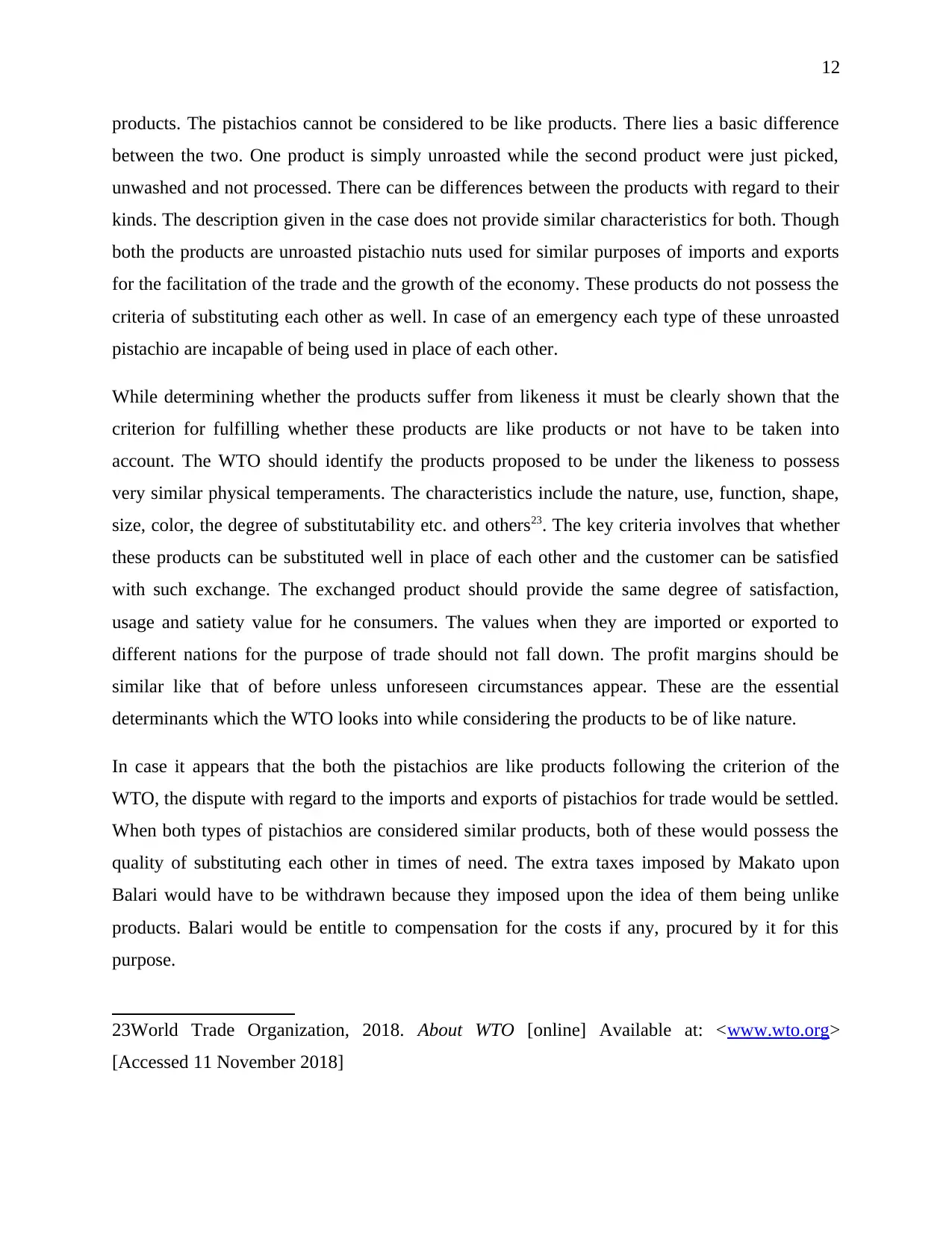
12
products. The pistachios cannot be considered to be like products. There lies a basic difference
between the two. One product is simply unroasted while the second product were just picked,
unwashed and not processed. There can be differences between the products with regard to their
kinds. The description given in the case does not provide similar characteristics for both. Though
both the products are unroasted pistachio nuts used for similar purposes of imports and exports
for the facilitation of the trade and the growth of the economy. These products do not possess the
criteria of substituting each other as well. In case of an emergency each type of these unroasted
pistachio are incapable of being used in place of each other.
While determining whether the products suffer from likeness it must be clearly shown that the
criterion for fulfilling whether these products are like products or not have to be taken into
account. The WTO should identify the products proposed to be under the likeness to possess
very similar physical temperaments. The characteristics include the nature, use, function, shape,
size, color, the degree of substitutability etc. and others23. The key criteria involves that whether
these products can be substituted well in place of each other and the customer can be satisfied
with such exchange. The exchanged product should provide the same degree of satisfaction,
usage and satiety value for he consumers. The values when they are imported or exported to
different nations for the purpose of trade should not fall down. The profit margins should be
similar like that of before unless unforeseen circumstances appear. These are the essential
determinants which the WTO looks into while considering the products to be of like nature.
In case it appears that the both the pistachios are like products following the criterion of the
WTO, the dispute with regard to the imports and exports of pistachios for trade would be settled.
When both types of pistachios are considered similar products, both of these would possess the
quality of substituting each other in times of need. The extra taxes imposed by Makato upon
Balari would have to be withdrawn because they imposed upon the idea of them being unlike
products. Balari would be entitle to compensation for the costs if any, procured by it for this
purpose.
23World Trade Organization, 2018. About WTO [online] Available at: <www.wto.org>
[Accessed 11 November 2018]
products. The pistachios cannot be considered to be like products. There lies a basic difference
between the two. One product is simply unroasted while the second product were just picked,
unwashed and not processed. There can be differences between the products with regard to their
kinds. The description given in the case does not provide similar characteristics for both. Though
both the products are unroasted pistachio nuts used for similar purposes of imports and exports
for the facilitation of the trade and the growth of the economy. These products do not possess the
criteria of substituting each other as well. In case of an emergency each type of these unroasted
pistachio are incapable of being used in place of each other.
While determining whether the products suffer from likeness it must be clearly shown that the
criterion for fulfilling whether these products are like products or not have to be taken into
account. The WTO should identify the products proposed to be under the likeness to possess
very similar physical temperaments. The characteristics include the nature, use, function, shape,
size, color, the degree of substitutability etc. and others23. The key criteria involves that whether
these products can be substituted well in place of each other and the customer can be satisfied
with such exchange. The exchanged product should provide the same degree of satisfaction,
usage and satiety value for he consumers. The values when they are imported or exported to
different nations for the purpose of trade should not fall down. The profit margins should be
similar like that of before unless unforeseen circumstances appear. These are the essential
determinants which the WTO looks into while considering the products to be of like nature.
In case it appears that the both the pistachios are like products following the criterion of the
WTO, the dispute with regard to the imports and exports of pistachios for trade would be settled.
When both types of pistachios are considered similar products, both of these would possess the
quality of substituting each other in times of need. The extra taxes imposed by Makato upon
Balari would have to be withdrawn because they imposed upon the idea of them being unlike
products. Balari would be entitle to compensation for the costs if any, procured by it for this
purpose.
23World Trade Organization, 2018. About WTO [online] Available at: <www.wto.org>
[Accessed 11 November 2018]
⊘ This is a preview!⊘
Do you want full access?
Subscribe today to unlock all pages.

Trusted by 1+ million students worldwide
1 out of 16
Related Documents
Your All-in-One AI-Powered Toolkit for Academic Success.
+13062052269
info@desklib.com
Available 24*7 on WhatsApp / Email
![[object Object]](/_next/static/media/star-bottom.7253800d.svg)
Unlock your academic potential
Copyright © 2020–2025 A2Z Services. All Rights Reserved. Developed and managed by ZUCOL.




